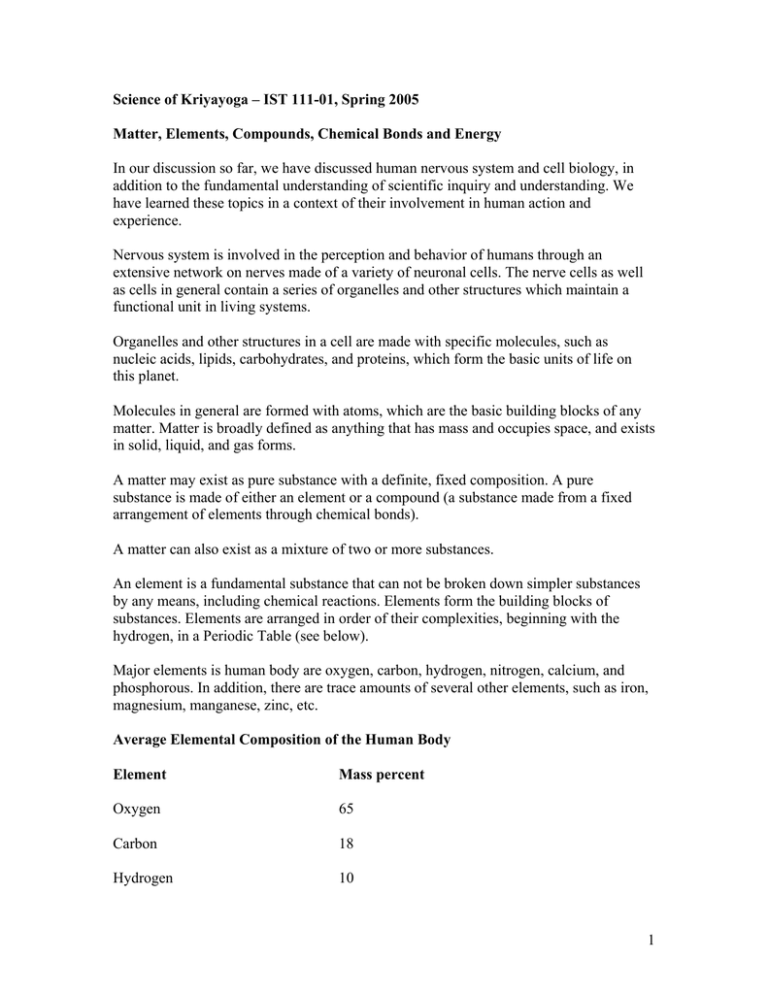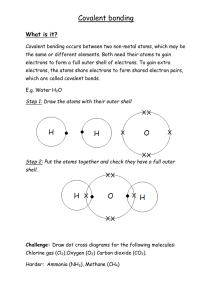Matter, Elements, Compounds, Chemical Bonds and Energy
advertisement

Science of Kriyayoga – IST 111-01, Spring 2005 Matter, Elements, Compounds, Chemical Bonds and Energy In our discussion so far, we have discussed human nervous system and cell biology, in addition to the fundamental understanding of scientific inquiry and understanding. We have learned these topics in a context of their involvement in human action and experience. Nervous system is involved in the perception and behavior of humans through an extensive network on nerves made of a variety of neuronal cells. The nerve cells as well as cells in general contain a series of organelles and other structures which maintain a functional unit in living systems. Organelles and other structures in a cell are made with specific molecules, such as nucleic acids, lipids, carbohydrates, and proteins, which form the basic units of life on this planet. Molecules in general are formed with atoms, which are the basic building blocks of any matter. Matter is broadly defined as anything that has mass and occupies space, and exists in solid, liquid, and gas forms. A matter may exist as pure substance with a definite, fixed composition. A pure substance is made of either an element or a compound (a substance made from a fixed arrangement of elements through chemical bonds). A matter can also exist as a mixture of two or more substances. An element is a fundamental substance that can not be broken down simpler substances by any means, including chemical reactions. Elements form the building blocks of substances. Elements are arranged in order of their complexities, beginning with the hydrogen, in a Periodic Table (see below). Major elements is human body are oxygen, carbon, hydrogen, nitrogen, calcium, and phosphorous. In addition, there are trace amounts of several other elements, such as iron, magnesium, manganese, zinc, etc. Average Elemental Composition of the Human Body Element Mass percent Oxygen 65 Carbon 18 Hydrogen 10 1 Nitrogen Calcium 3 2 Phosphorous 1 Trace elements 1 Basic unit of any element is atom. Atoms of each element are unique and identical. Each atom is made up of a nucleus that contains protons (which are positively charged) and neutrons, which carry no charge. Electrons (which are negatively charged) are located in orbitals around the nucleus. Contrary to general belief, electrons do not orbit around the nucleus. These have rather high probabilities of being found in those orbitals. electron electron proton proton neutron Electrons, protons, and neutrons are known as subatomic particles. The mass of an electron is 9.110 x 10-28 g, whereas mass of a proton or a neutron is 1.673 x 10-24 g. Chemically two or more elements can combine in a definite proportion (by mass) to form compounds. A molecule is the smallest uncharged individual unit of a compound formed by the union of two or more atoms. For example, hydrogen gas (H2) is formed by the union of two hydrogen atoms (H). Water (H2O) is formed by the combination of two hydrogens (H ) and one oxygen (O). Mechanism by which molecules are formed from atoms is known as chemical bonding, in which electrons of different atoms are either shared or given out and taken in. It is important to examine the arrangement of atoms of various elements in a periodic Table (Table 1). The periodic table has 7 rows (periods) or elements arranged in the increasing order of their atomic number (the number of protons or electrons in an atom). Each period with the exception of H begins with ends with a noble gas (Table 1). The H atom has one proton, one electron, and no neutron. The next atom in the periodic table is He (helium) which as two protons, two neutrons, and two electrons, and is a 2 noble gas. The next element in the periodic table is lithium (Li) which has 3 proton, 3 electron and 3 neutrons Table 1: Periodic Table While protons and neutrons are located in the nucleus of an atom, electrons are located outside the nucleus in electronic shells. The first shell can accommodate up to 2 electrons, second shell can accommodate up to 8 electrons, the third electronic shell can accommodate up to 18 electrons. When an atom has only one electronic shell, which is filled it gives a noble configuration, such as helium (He) 1P+ 0N Structure of H 2P+ 2N Structure of He 3 Lithium (Li with 3 electrons) of Group IA (in the periodic table) fills the first electronic shell and puts the additional electron in the second electronic shell. Fluorine (F with 9 electrons) in Group VIIA, on the other hand, fills first shell with 2 electrons, and puts 7 electrons in the second shell. Neon (Ne, a noble gas, with 10 electrons) puts 2 electrons in the first shell and the remaining 8 in the second shell. 3P+ 3N Li 9P+ 9N F 10P+ 10N Ne Electronic structures of Li, F, and Ne. Similarly, sodium (Na with 11 electrons) fills first two shells with 2 and 8 electrons respectively, and places the remaining electron in the third shell. Chlorine (Cl with 17 electrons) puts 2, 8, and 7 electrons in the first three shells, respectively. Argon (Ar, a noble gas, with 18 electrons) has 2, 8, and 8 electrons, in its first three shells. 11P+ 11N Na 17P+ 17N Cl 18P+ 18N Ar Electronic Structures of Na, Cl, and Ar. It is notable that the two noble gases, Ne and Ar, have 8 electrons in their outermost shells. This is called as Octet state, and is considered as the electronic basis of noble gas behavior. He is another noble gas, which has a duet state, with 2 electrons in its outermost shell. Except for He all other noble gases follow the octet state. 4 All other elements tend to achieve the noble electronic configuration. The Group IA elements, such as H, Li, and Na, with one electron each in their outermost shells tend to lose that electron to achieve either duet (Li) or octet (Na) state. H is an exception that can lose an electron to pretend a noble configuration, or share an electron to reach the duet state (more later on sharing of the electron). Losing of an electron by these atoms makes them positively charged, as the number of protons (positively charged) and electrons (negatively charged) must remain the same to keep the atom neutral. Loss of an electron makes one proton excess, and thus a positive charge. Charged atoms in general are known as ions, and these positively charged atoms are known as cations. 1P+ 0N 11P+ 11N 3P+ 3N H+ Li+ Na+ Electronic configuration of H+, Li+, and Na+. The elements in Group VIIA, such as F and Cl, with 7 electrons in their outermost shell also tend to achieve the noble electronic configuration, by accepting an additional electron in their outermost shell to make it 8, the octet state. Of course, accepting an extra electron makes these atoms negatively charged ions, which are known as anions. 9P+ 9N F- 17P+ 17N Cl- Electronic configuration of F- and Cl-. 5 Chemical Bonds When cations and anions are together, they attract each other with electrical force of opposite charges. Holding together of anions and cations through charge attraction is called ionic bond. In ionic bond, transfer of electrons occur from one atom to another atom. For example, transfer of an electron occurs from Na to Cl to form Na+ and Cl- to form ionic bond between Na+ and Cl- yielding NaCl, which is the chemical formula for salt which we consume in food. 11P+ 11N + Na 17P+ 17N Cl 11P+ 11N + 17P+ 17N Na+_ _ _ _ _ _ _ _ _ _ClElectrical attraction Ionic bond between Na and Cl, showing the electronic structures. Similar ionic bonds are formed between H and Cl to yield hydrochloric acid, or between Li and F to yield LiF, of lithium fluoride. 6 Covalent bonds Some atoms achieve the stable octet state by sharing electrons in their outermost shells, rather than transferring the electrons. A covalent bond is formed when a pair of electrons is shared between two atoms, one electron each provided by the atoms sharing them. For example, two H atoms share their one electron each to achieve the duet state of noble gas, He. Or H H Covalent sharing Sharing of electrons between two H atoms to form H2 gas. It is notable that for showing covalent bonds, only outermost electrons are shown around the atom. This kind of representation of atoms is called the Lewis structure, named after the Gilbert N. Lewis who introduced it in 1916. A similar covalent structure is formed between carbon, C (with 4 electrons in the outermost shell), and H to yield methane (CH4), a component of natural gas. H H C H H Covalent bond structure of methane. Water (H2O) consists of two H atom and one oxygen (O, with 6 electrons in its outermost shell) linked through covalent bonds between H and O. Carbon dioxide (CO2) is formed through covalent bonds between C and two O atoms. In each of these cases, atoms achieve the noble gas configuration of duet (for H) or octet state (C and O). OR H2O, water O C O CO2, Carbon Dioxide Covalent structures of water and carbon dioxide molecules. 7 Coordinate Covalent Bonds In a coordinate covalent bond, the pair of electrons being shared is provided by only one atom. For example, in carbon monoxide (CO) there is only O to share two electrons. While octet state is achieved for the O, the carbon with 4 electrons in its outer shell achieves only 6 electrons after sharing two electrons with O. Since O has a total of 6 electrons in its outer shell, it can furnish 2 additional electrons and share them with C, thus forming coordinate covalent bond. Coordinate covalent bonds are designated by an arrow, rather than line generally used for covalent bonds. C O OR C O Coordinate covalent bond in carbon monoxide. 8


